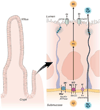Discovery and development of antisecretory drugs for treating diarrheal diseases
- PMID: 24316107
- PMCID: PMC3935719
- DOI: 10.1016/j.cgh.2013.12.001
Discovery and development of antisecretory drugs for treating diarrheal diseases
Abstract
Diarrheal diseases constitute a significant global health burden and are a major cause of childhood mortality and morbidity. Treatment of diarrheal disease has centered on the replacement of fluid and electrolyte losses using oral rehydration solutions. Although oral rehydration solutions have been highly successful, significant mortality and morbidity due to diarrheal disease remains. Secretory diarrheas, such as those caused by bacterial and viral enterotoxins, result from activation of cyclic nucleotide and/or Ca(2+) signaling pathways in intestinal epithelial cells, enterocytes, which increase the permeability of Cl(-) channels at the lumen-facing membrane. Additionally, there is often a parallel reduction in intestinal Na(+) absorption. Inhibition of enterocyte Cl(-) channels, including the cystic fibrosis transmembrane conductance regulator and Ca(2+)-activated Cl(-) channels, represents an attractive strategy for antisecretory drug therapy. High-throughput screening of synthetic small-molecule collections has identified several classes of Cl(-) channel inhibitors that show efficacy in animal models of diarrhea but remain to be tested clinically. In addition, several natural product extracts with Cl(-) channel inhibition activity have shown efficacy in diarrhea models. However, a number of challenges remain to translate the promising bench science into clinically useful therapeutics, including efficiently targeting orally administered drugs to enterocytes during diarrhea, funding development costs, and carrying out informative clinical trials. Nonetheless, Cl(-) channel inhibitors may prove to be effective adjunctive therapy in a broad spectrum of clinical diarrheas, including acute infectious and drug-related diarrheas, short bowel syndrome, and congenital enteropathies.
Keywords: CFTR; Ca(2+)-activated Cl(-) channels; CaCC; Chloride Channels; Diarrhea; HIV; ORS; Rotavirus; Small Molecules; cystic fibrosis transmembrane conductance regulator; human immunodeficiency virus; oral rehydration solution.
Copyright © 2014. Published by Elsevier Inc.
Conflict of interest statement
Conflict of interest statement: No relevant conflicts of interest exist
Figures


References
-
- Binder HJ. Mechanisms of diarrhea in inflammatory bowel diseases. Ann NY Acad Sci. 2009;1165:285–293. - PubMed
-
- Green PH, Jabri B. Celiac disease. Annu Rev Med. 2006;57:207–221. - PubMed
-
- Canani RB, Terrin G. Recent progress in congenital diarrheal disorders. Curr Gastroenterol Rep. 2011;13:257–264. - PubMed
Publication types
MeSH terms
Substances
Grants and funding
- R24 DK099803/DK/NIDDK NIH HHS/United States
- R01 EY013574/EY/NEI NIH HHS/United States
- R01 EB000415/EB/NIBIB NIH HHS/United States
- R01 DK035124/DK/NIDDK NIH HHS/United States
- P30 DK072517/DK/NIDDK NIH HHS/United States
- P30 DK089502/DK/NIDDK NIH HHS/United States
- DK72517/DK/NIDDK NIH HHS/United States
- EY13574/EY/NEI NIH HHS/United States
- R01 DK026523/DK/NIDDK NIH HHS/United States
- DK35124/DK/NIDDK NIH HHS/United States
- EB00415/EB/NIBIB NIH HHS/United States
- R37 DK035124/DK/NIDDK NIH HHS/United States
- R37 EB000415/EB/NIBIB NIH HHS/United States
LinkOut - more resources
Full Text Sources
Other Literature Sources
Medical
Miscellaneous

